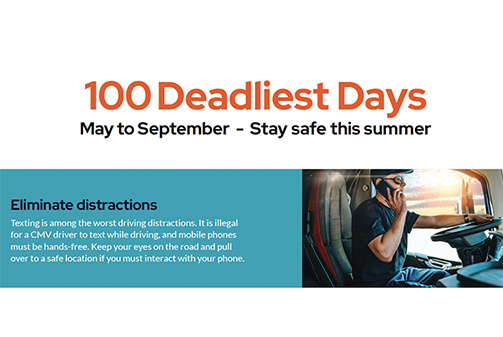How to help your fleet navigate the 100 Deadliest Days of Summer

Every year, the period between Memorial Day and Labor Day – known as the 100 Deadliest Days of Summer – brings a spike in roadway dangers. For fleet drivers, this time calls for increased vigilance, not just for their own safety, but for the safety of everyone they share the road with.
Before the drivers in your fleet hit the road this summer, it’s helpful to make them aware of this disturbing but preventable annual trend. Here’s how you can better understand the risks and what steps your drivers can take to stay safe on the road this summer.
Why are these days so dangerous?
From May through early September, the roads see increased traffic violations, more frequent congestion, and variety of high-risk behaviors. Here’s what makes this period especially hazardous:
- More vehicles: Families traveling for vacations, teen drivers out of school, and weekend warriors towing boats or campers they’re not used to.
-
Inexperienced drivers:Teenagers and infrequent drivers dominate the roadways, increasing unpredictability. Younger and more inexperienced drivers have not yet learned the skills to recognize and avoid potentially dangerous situations on the road.According to the CDC, teen drivers have a higher risk of vehicle crashes than any other age group. 60% of teen crashes are caused by distracted driving, with other passengers being the top distraction. Additionally, teens have lower seat belt usage rates and are more likely to speed.
- Distractions and fatigue: Longer daylight hours, more congestion, and hotter conditions all contribute to mental and physical strain and fatigue.
Other contributing factors include:
- Equipment failure: Rising temperatures can wreak havoc on your trucks. The risk of overheating engines is significantly higher in the summer months, and frequent stops and starts in construction zones or traffic jams cause more wear on brakes and tires.
- Drunk or drowsy driving: The warm weather and longer days increase the likelihood and frequency of parties and gatherings, many of which will include alcohol and extend well into nighttime hours. Keep an eye out for vehicles driving erratically or struggling to maintain speed or stay in their lane and move away from them as quickly and safely as possible.
-
More construction: In many states, the summer season means a dramatic increase in construction projects – which means lane closures, detours and traffic backups. It’s easy for frustration levels to rise in construction zones, and that frustration can cause drivers to become impatient or aggressive.To keep yourself (and other drivers) safe during construction season, it’s even more important than usual to stay focused on the road. Remember to watch your speed and maintain a safe following distance. It’s also critical to keep a close eye on the vehicles around you – passenger cars will often change lanes unexpectedly. While you won’t be able to avoid every construction zone, check your routes ahead of time and plan alternate routes if possible.
What you can do as a professional driver
Here are key practices to keep you and others safe this summer:
Eliminate Distractions
- Practice “one thing at a time.” Humans aren’t great multitaskers.
- Avoid phone use – even with Bluetooth, 60% of your cognitive attention is lost to conversation.
-
If you must call or text, pull over in a safe spot first.Distracted driving is more than just texting, however. Any activity that takes your eyes off the road and your attention away from driving can increase your risk. Eating and drinking, talking to passengers, reaching for something in your console or even choosing what podcast to listen to can put you in danger.Even if you’re fully focused on the road, other drivers might not be: one-third of teens and many adults admit to texting while driving. Keep your eyes on the road at all times to make sure you’re aware of the actions of other drivers.Fleet owners and operators should be talking to drivers regularly about the dangers distracted drivers pose to truckers. It’s also a good idea to provide defensive driving training if your fleet spends time in areas such as New Mexico and Louisiana where distracted driving fatalities are highest.
Master your pre-trip and post-trip inspections
- Do a thorough walk around before and after every trip.
- Ensure your equipment is safe before hitting the road and give yourself peace of mind at the end of the day.
Drive defensively and be predictable
- Share the road with motorcycles, bicyclists, pedestrians, inexperienced, and over-confident drivers.
- Don’t speed. Speeding increases the severity of all crashes.
- Watch your following distance: the recommendation is 1 vehicle length for every 10 MPH on your speedometer. Leave yourself an out should the vehicle in front of you stop or swerve suddenly.
- Stay cool and calm in reaction to other motorists’ poor choices. Don’t react emotionally.
Get the rest you need
- Don’t skimp on sleep. Driver fatigue is a leading cause of crashes.
- Nap when needed. A well-rested driver is an alert and responsive driver.
Professional drivers are key to keeping the roads safe
The benefits of professionalism
Maintaining discipline and following safety guidelines leads to safer roads and a safety record your team and drivers can be proud of. You don’t just stay safe – you set the standard:
- Fewer breakdowns and delays
- Fewer enforcement stops and violations
- Enhanced reputation for you and your company
- Improved public safety
- Pride in your work, lower stress, and better well-being
Be cool. Be smart. Be rested. Be on time.
One of the best things you can do is to make sure your drivers and office team are prepared for the days ahead by keeping safety top of mind.
Download and share this infographic with your drivers to remind them to be extra careful during the 100 deadliest days.
And remember, you and your drivers’ dedication and professionalism are what make our roads safer. During these 100 Deadliest Days, take extra pride in every mile. Let’s all make it through summer safely and stronger than ever.
Editor’s Note: This post was originally published in June 2022, but has been updated multiple times to make sure we continue providing the most accurate and comprehensive information available.


